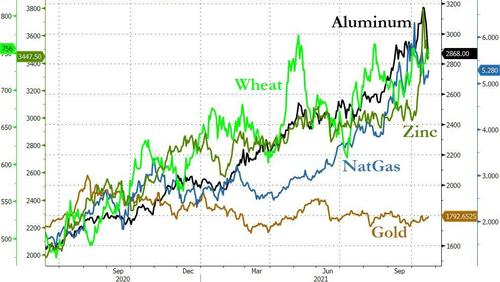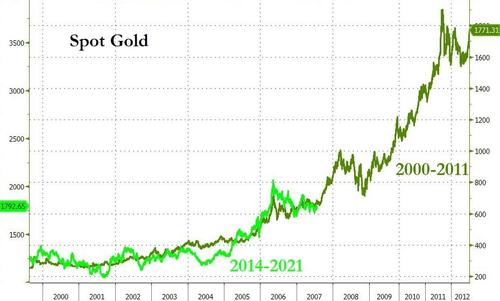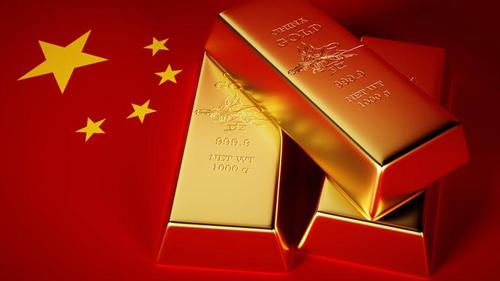$3000 In Months, Not Years - Gold's Inflation-Protection Means Violent Run-Up Imminent
While cryptocurrencies have been stealing the headlines recently with record highs amid 'inflation hedge' narratives, commodities have put in a strong performance amid supply chain shocks and unprecedented demand interference (monetary/fiscal policy). As everything from copper to crude and aluminum to zinc has soared, one metal has lagged...
But, as Bloomberg reports, two of the biggest names in Canadian mining - the former chiefs of Goldcorp, David Garofalo and Rob McEwen - predict investors will catch on soon that global inflationary pressures are far less transitory and more intense than central bankers and hedonically-adjusted consumers price indexes suggest.
When that realization sets in, gold's inflation-protection appeal probably will send prices to $3,000 an ounce, from about $1,800 now, according to Garofalo. Such a run-up would be a "down-payment" to McEwen's $5,000 long term prediction.
"I'm talking about months," he said.
"The reaction tends to be immediate and violent when it does happen. That's why I'm quite confident that gold will achieve $3,000 an ounce in months not years."
McEwen warns that the global monetary and debt expansion to cope with the pandemic, as well as secondary drivers associated with supply disruptions, will have people turning back to traditional methods of protecting wealth.
"It's not just the dollar," he said.
"All currencies are buying less than what they were buying a year ago. So I look at that as an unprecedented development at least in our lives that is going to affect the value of fiat currencies around the world."
We have seen this kind of delayed response before...
As Peter Schiff recently noted, the knock on gold and silver has always been that you forgo interest. Higher interest rates increase the opportunity cost of owning the metals. For example, if interest rates are 10% and you own gold, you're giving up 10% interest on the money you have in the yellow metal. But when rates are negative, it doesn't matter.
If they're negative 2% or negative 10%, nobody wants a negative yield. So, as long as yields are negative, you want to get out of bonds. It doesn't matter how negative. Once you're losing, it's a loss."
Ultimately, a negative rate environment, no matter how negative, should be bullish for gold and silver.
The other tailwind for gold and silver is traders still expect the Federal Reserve to respond to inflation by tightening monetary policy - and thus raising interest rates.
Oil prices are rising as a result of inflation. Gold should also be rising as a result of inflation. It should not be falling because investors expect the Fed to fight inflation. Again, if the Fed could fight inflation, they'd be fighting it right now. The reason they're not fighting it, the reason they're pretending that it's not a problem, and so there's no need to fight it, is because they can't. But they're never going to admit that. That would be a complete disaster. So, they have to pretend that it's transitory, that it's not a real problem, but also pretend that if it ever becomes a real problem, well, they're going to do something about it. But of course, they can't do anything about it. So, they won't."
But while price has lagged, there are plenty that are using this 'cheapness' to back up the truck.
Gold demand in China was up in September, as the country approaches a peak gold-buying season. September is typically a strong month for wholesale gold demand in China as it leads up to an important holiday season. October is traditionally a big month for gold jewelry sales during the seven-day National Day Holiday in early in the month. Both gold withdrawals from the Shanghai Gold Exchange (SGE) in September and gold imports in August were up, a sign that the Chinese gold market continues to recover after it was hit hard by the coronavirus pandemic.
Rising local premiums also signal growing demand for gold in China. The local gold price premium rose for the third straight month in September, averaging US$7.5/oz. That was $1.70 higher month-on-month.
So, it appears the Chinese (and the Russians) get it and Peter Schiff thinks the markets will figure this out eventually.
In an inflationary environment - and we are in the most inflationary environment we've ever been in - the riskiest things you can own are bonds. And it doesn't matter what bond you have. Treasuries are no safer than the riskiest junk bond when the threat is the loss of purchasing power to inflation. The real safe haven in this environment is gold. And as soon as investors understand the difference between gold and Treasuries, they will then start moving into gold as a safe haven, and they will not be deterred in their buying of gold when bonds go down because they will expect bonds to go down. When you're looking to remove inflation risk from your portfolio, you sell bonds, including Treasuries, and you buy gold and silver."
Its universality and 4,000 year-old history mean gold is better positioned than crypto-currencies as a hedge against an inflationary environment that "will have deep and meaningful impacts on our capital," Garofalo concluded.


